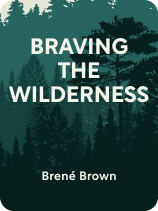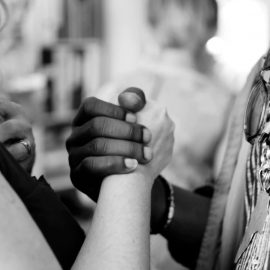

This article is an excerpt from the Shortform book guide to "Braving the Wilderness" by Brené Brown. Shortform has the world's best summaries and analyses of books you should be reading.
Like this article? Sign up for a free trial here.
Do you have a hard time sustaining relationships? What are ways to make long-lasting connections?
In Braving the Wilderness, Brené Brown provides advice for finding true belonging, which means making friends while also staying true to yourself. She covers four strategies that range from resolving conflicts with curiosity to building trust in yourself and others.
Let’s unpack how to connect with other people using her four strategies.
Strategy 1: Resolve Conflicts With Curiosity and Healthy Boundaries
Brown says part of true belonging means speaking up with your honest opinion, even when it could create conflict. This means you must be prepared to resolve conflicts by approaching them with curiosity rather than defensiveness or hostility. If everyone could try to understand other people’s perspectives and talk through conflicts with kindness, Brown says, people would feel more comfortable being their true selves because they wouldn’t be afraid of a negative reaction.
In other words, having a safe space to disagree facilitates true belonging and helps you learn how to connect with other people. Even a more neutral stance, like “Since we disagree on this topic, let’s not talk about it,” hinders connection and true belonging because you might feel like you have to suppress your opinions to avoid conflict.
For example, in the earlier scenario of friends who disagree on climate change policies, Brown might recommend that the friends show curiosity by asking each other questions about why they believe the way they do: “What’s your rationale for this stance? How do you think this policy might affect people?” Brown emphasizes that this dialogue should always be respectful and should allow each person to understand the other’s intentions. In this case, the friends who disagree may have the same intention: reducing the impact of climate change in the most practical way possible. They simply have different approaches to doing so.
Brown’s conflict resolution strategy comes with a caveat: It should always be done with healthy boundaries in place. This means that you shouldn’t engage with someone if you feel physically or emotionally unsafe. For example, if someone is trying to physically threaten or intimidate you, or if they’re using dehumanizing language, this isn’t a safe space for productive conflict resolution. In this case, extract yourself from the situation rather than engaging.
Strategy 2: Question False Dichotomies
Brown’s next piece of advice for achieving true belonging is to question false dichotomies—the types of things people might say when they have the “us versus them” mindset. For example, if someone says that you can’t consider yourself a Christian if you hold certain opinions, this assertion is a way of trying to bully you into either conforming or losing your membership in a community.
In these situations, Brown says that true belonging requires calling people out on this and adding nuance while staying respectful. In this scenario, you might point out that many Christians have different opinions, explain why you think your opinion and faith aren’t mutually exclusive, and try the conflict resolution techniques we described in the previous section.
Strategy 3: Remember What Unites Us as Humans
Another way to foster true belonging is to increase our shared connection as humans. Brown says we can remember what unites us by being present with others during euphoric and painful moments. These include gatherings of people—especially with strangers—such as a group working together on a task (like building a house) or a large protest.
The commonality in these gatherings is a shared emotional experience: Love, grief, and everything in between are what bind us together as humans, no matter how different we may seem or how challenging it can be to relate to one another. Brown notes that in-person interactions are essential for feeling the power of a shared emotional experience because digital “gatherings” don’t quite have the same impact as being together in the same physical place.
Strategy 4: Build Trust
Building trust is another key way to achieve true belonging. Brown says that trusting yourself as well as others will help you express your true self and avoid withdrawing into yourself or lashing out at others out of fear. Her definition of trust has several elements. To understand what building trust looks like in practice, we’ll explain each of these elements using Brown’s acronym BRAVING:
Boundaries: When you trust yourself, you know when to draw the line at physical and emotional safety during a disagreement. When you trust other people’s boundaries, you know that they’ll do the same.
Reliability: When you’re reliable, people can trust that you’ll always be honest and won’t pretend to conform for ease. They know that you always show up as your authentic self. People should also be able to trust that you’re reliable because you don’t present them with false dichotomies.
Accountability: If you’re trustworthy, you take accountability when you mess up by not being authentic or not engaging in conflict resolution in good faith. In those cases, you show accountability by apologizing and trying again.
Vault: You keep things confidential when you say you will—even if you’re tempted to connect with people through gossip or shared contempt.
Integrity: When you have integrity, you always live out your values, even when it’s more challenging than conforming. This is an important part of calling out false dichotomies and being honest with others.
Nonjudgment: In order for people to trust you with their truth, you have to listen to them without judgment. Likewise, to trust yourself, you have be nonjudgmental toward yourself even when you feel different or “othered.”
Generosity: When people trust you, they know that when you ask more questions to understand their perspective, you’re assuming generous (good) intentions and you’re approaching the conversation with kindness.

———End of Preview———
Like what you just read? Read the rest of the world's best book summary and analysis of Brené Brown's "Braving the Wilderness" at Shortform.
Here's what you'll find in our full Braving the Wilderness summary:
- What true belonging means and why you shouldn't strive to be accepted
- Why it can be so challenging to be truly genuine
- 4 strategies for how to find true belonging






